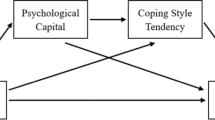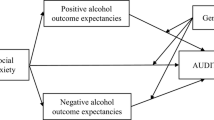Abstract
Smoking is one of the more common preventable threats to public health, and it remains a serious cause of death around the world. Remarkably, the mean age of the onset of cigarette smoking is decreasing. Therefore, it is necessary to increase our knowledge concerning the attitude among high school students towards cigarette smoking. The present study sought to examine the associations among social anxiety, emotional intelligence, and attitudes towards cigarette smoking, and to examine emotional intelligence as a mediator between social anxiety and attitude towards cigarette smoking. The participants comprised 950 high school students who completed the Liebowitz Social Anxiety Scale, Assessing Emotions Scale, and Attitudes Towards Cigarette Smoking Scale. Structural equation modelling analyses indicated that high levels of emotional intelligence are negatively associated with positive attitude towards cigarette smoking and social anxiety is associated with a positive attitude towards cigarette smoking in high school students. Emotional intelligence partially mediated the relationship between social anxiety and attitude towards cigarette smoking. These relationships varied as a function of gender.

Similar content being viewed by others
References
Abdollahi, A., Abu Talib, M., & Motalebi, S. A. (2013). Perceived parenting styles and emotional intelligence among Iranian boy students. Asian Journal of Social Sciences & Humanities, 2(3), 460–467.
Abdollahi, A., & Talib, M. A. (2014). Hardiness and problem-solving skills as preventive factors against smoking among adolescents. Asian Social Science, 10(8), p165.
Abdollahia, A., & Talib, M. A. (2014). To examine the relationships between emotional intelligence, locus of control and smoking in adolescents. The Social Sciences, 9(3), 157–162.
American Psychiatric Association. (2000). Diagnostic and statistical manual of mental disorders-TR. Washington, DC: American Psychiatric Association.
Barahmand, U., & Shahbazi, Z. (2013). Prevalence of and associations between body dysmorphic concerns, obsessive beliefs and social anxiety. Asia-Pacific Psychiatry. doi:10.1111/appy.12085.
Breslau, N., Novak, S. P., & Kessler, R. C. (2004). Psychiatric disorders and stages of smoking. Biological Psychiatry, 55(1), 69–76.
Buckner, J. D., & Vinci, C. (2013). Smoking and social anxiety: The roles of gender and smoking motives. Addictive Behaviors. doi:10.1016/j.addbeh.2013.03.007
Byrne, B. M. (2010). Structural equation modeling with AMOS: Basic concepts, applications, and programming (2nd ed.). Mahwah, NJ: Lawrence Erlbaum. Retrieved from http://www.amazon.com/dp/0805863737
Davis, J. W. (2008). Handbook of univariate and multivariate data analysis and interpretation with SPSS. The American Statistician, 62(3), 268. doi:10.1198/000313008X332287
Duncan, L. R., Bertoli, M. C., Latimer-Cheung, A. E., Rivers, S. E., Brackett, M. A., & Salovey, P. (2012). Mapping the protective pathway of emotional intelligence in youth: From social cognition to smoking intentions. Personality and Individual Differences, 54(4), 542–544.
Eisner, L. R., Johnson, S. L., & Carver, C. S. (2009). Positive affect regulation in anxiety disorders. Journal of Anxiety Disorders, 23(5), 645–649. doi:10.1016/j.janxdis.2009.02.001
Garrosa, E., Rainho, C., Moreno-Jiménez, B., & Monteiro, M. J. (2010). The relationship between job stressors, hardy personality, coping resources and burnout in a sample of nurses: A correlational study at two time points. International Journal of Nursing Studies, 47(2), 205–215. doi:10.1016/j.ijnurstu.2009.05.014
Hagger-Johnson, G., Sabia, S., Nabi, H., Brunner, E., Kivimaki, M., Shipley, M., & Singh-Manoux, A. (2012). Low conscientiousness and risk of all-cause, cardiovascular and cancer mortality over 17 years: Whitehall II cohort study. Journal of Psychosomatic Research, 73(2), 98–103. doi:10.1016/j.jpsychores.2012.05.007
Hair, J. F., Black, W. C., Babin, B. J., Anderson, R. E., & Tatham, R. L. (2006). Multivariate data analysis: A global perspective (c) (Vol. 7). Upper Saddle River, NJ: Pearson. Retrieved from http://digitalcommons.kennesaw.edu/
Hayes, A. F. (2008). Asymptotic and resampling strategies for assessing and comparing indirect effects indirect effects in multiple mediator models. Behavior Research Methods, 40(3), 879–891. doi:10.3758/BRM.40.3.879
Hayes, A. F. (2009). Beyond Baron and Kenny: Statistical mediation analysis in the new millennium. Communication Monographs, 76(4), 408420. doi:10.1080/03637750903310360
Henry, S. L., Jamner, L. D., & Whalen, C. K. (2012). I (should) need a cigarette: Adolescent social anxiety and cigarette smoking. Annals of Behavioral Medicine, 43(3), 383–393. doi:10.1007/s12160-011-9340-7
Hill, E. M., & Maggi, S. (2011). Emotional intelligence and smoking: Protective and risk factors among Canadian young adults. Personality and Individual Differences, 51(1), 45–50. doi:10.1016/j.paid.2011.03.008
Kirk, B. A., Schutte, N. S., & Hine, D. W. (2008). Development and preliminary validation of an emotional self-efficacy scale. Personality and Individual Differences, 45(5), 432–436. doi:10.1016/j.paid.2008.06.010
Kline, R. B. (2010). Principles and practice of structural equation modeling. New York: The Guilford Press. Retrieved from http://books.google.com.my
Kun, B., & Demetrovics, Z. (2010). Emotional intelligence and addictions: A systematic review. Substance Use and Misuse, 45(7–8), 1131–1160.
Lasser, K., Boyd, J. W., Woolhandler, S., Himmelstein, D. U., McCormick, D., & Bor, D. H. (2000). Smoking and mental illness: A population-based prevalence study. Journal of American Medical Association, 284(20), 2606–2610. doi:10.1001/jama.284.20.2606
Liebowitz, M. R. (1987). Social phobia. Modern Problems of Pharmacopsychiatry, 22, 141–173.
Limonero, J. T., Tomás-Sábado, J., & Fernández-Castro, J. (2006). Perceived emotional intelligence and its relation to tobacco and cannabis use among university students. Psicothema, 18(Suppl.), 95–100.
Mayer, J. D., & Salovey, P. (1993). The intelligence of emotional intelligence. Intelligence, 17(4), 433–442. doi:10.1016/0160-2896(93)90010-3
Moxham, L., Dwyer, T., & Reid-Searl, K. (2012). Graduate nurses and nursing student’s behaviour: Knowledge and attitudes toward smoking cessation. Nurse Education Today,. doi:10.1016/j.nedt.2012.11.024
Nazarzadeh, M., Bidel, Z., Ayubi, E., Bahrami, A., Jafari, F., Mohammadpoorasl, A., … Taremian, F. (2013). Smoking status in Iranian male adolescents: A cross-sectional study and a meta-analysis. Addictive Behaviors, 38(6), 2214–8. doi:10.1016/j.addbeh.2013.01.018
Niaura, R., Shadel, W. G., Britt, D. M., & Abrams, D. B. (2002). Response to social stress, urge to smoke, and smoking cessation. Addictive Behaviors, 27(2), 241–250.
Riahi, M. E., Aliverdinia, A., & Soleymani, M. R. (2009). Attitude of the boy’s students toward the cigarette smoking in Ghaemshar city. Iranian Journal of Epidemiology, 5(3), 44–54.
Rudatsikira, E., Muula, A. S., Siziya, S., & Mataya, R. H. (2008). Correlates of cigarette smoking among school-going adolescents in Thailand: Findings from the Thai global youth tobacco survey 2005. International Archives of Medicine, 1(1), 8. doi:10.1186/1755-7682-1-8
Schutte, N. S., & Malouff, J. M. (2011). Emotional intelligence mediates the relationship between mindfulness and subjective well-being. Personality and Individual Differences, 50(7), 1116–1119. doi:10.1016/j.paid.2011.01.037
Schutte, N. S., Malouff, J. M., Hall, L. E., Haggerty, D. J., Cooper, J. T., Golden, C. J., & Dornheim, L. (1998). Development and validation of a measure of emotional intelligence. Personality and Individual Differences, 25(2), 167–177. doi:10.1016/S0191-8869(98)00001-4
Spada, M. M., Nikčević, A. V., Moneta, G. B., & Wells, A. (2007). Metacognition as a mediator of the relationship between emotion and smoking dependence. Addictive Behaviors, 32(10), 2120–2129.
Sutterby, S. R., Bedwell, J. S., Passler, J. S., Deptula, A. E., & Mesa, F. (2012). Social anxiety and social cognition: The influence of sex. Psychiatry Research, 197(5), 242–245. doi:10.1016/j.psychres.2012.02.014
Trinidad, D. R., Unger, J. B., Chou, C.-P., & Anderson Johnson, C. (2004). The protective association of emotional intelligence with psychosocial smoking risk factors for adolescents. Personality and Individual Differences, 36(4), 945–954. doi:10.1016/S0191-8869(03)00163-6
Triplett, R., & Payne, B. (2004). Problem solving as reinforcement in adolescent drug use: Implications for theory and policy. Journal of Criminal Justice, 32(6), 617–630. doi:10.1016/j.jcrimjus.2004.08.012
Watson, N. L., VanderVeen, J. W., Cohen, L. M., DeMarree, K. G., & Morrell, H. E. R. (2012). Examining the interrelationships between social anxiety, smoking to cope, and cigarette craving. Addictive Behaviors, 37(8), 986–989.
Whalen, C. K., Jamner, L. D., Henker, B., & Delfino, R. J. (2001). Smoking and moods in adolescents with depressive and aggressive dispositions: Evidence from surveys and electronic diaries. Health Psychology, 20(2), 99.
World Health Organization. (2013). Tobacco cessation. Retrieved from http://www.who.int/mediacentre/factsheets/fs339/en/index.html
Conflict of interest
The author(s) asserted no potential conflicts of interest with respect to the research, authorship, and/or publication of this article.
Author information
Authors and Affiliations
Corresponding author
Rights and permissions
About this article
Cite this article
Abdollahi, A., Yaacob, S.N., Talib, M.A. et al. Social Anxiety and Cigarette Smoking in Adolescents: The Mediating Role of Emotional Intelligence. School Mental Health 7, 184–192 (2015). https://doi.org/10.1007/s12310-015-9141-4
Published:
Issue Date:
DOI: https://doi.org/10.1007/s12310-015-9141-4




